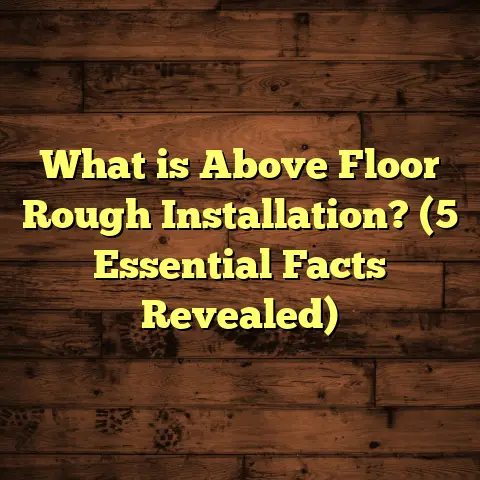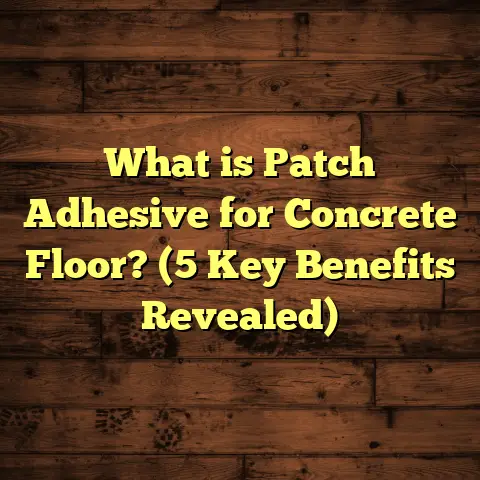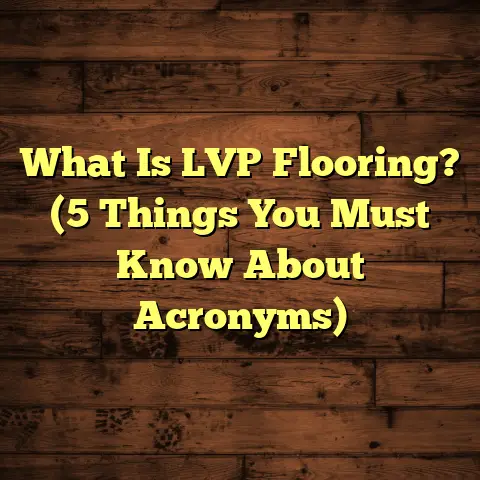What is Timber Strip Flooring? (5 Benefits for Your Home)
Have you ever stopped to think about how your lifestyle shapes the look and feel of your home? The spaces we live in should reflect who we are, our habits, and what makes us comfortable. When it comes to flooring, it’s not just about covering the ground beneath your feet; it’s about creating a foundation that supports your everyday life. I’ve spent years working with all kinds of flooring materials, but timber strip flooring holds a special place for me—and I want to share why.
What is Timber Strip Flooring?
Timber strip flooring is a type of solid wood flooring made from narrow strips of hardwood laid side by side. Usually, each strip measures between 19mm to 25mm wide, and they are joined edge-to-edge to create a continuous wooden surface. Unlike wider planks or engineered wood, these strips offer a consistent, linear pattern that can bring warmth and character to any room.
These strips commonly come in species like oak, maple, beech, and pine. The wood is often finished with a clear lacquer or oil to highlight the natural grain and protect the surface. Installation usually involves either nailing or gluing the strips directly onto a subfloor.
In practical terms, think of timber strip flooring as a classic, traditional wood floor but with a slimmer profile, which can make a big difference in style and performance. Over the years, I’ve installed timber strip floors in everything from cozy cottages to modern townhouses. Each time, the results have brought a timeless elegance combined with practical durability.
Why Choose Timber Strip Flooring?
You might wonder why someone would pick timber strip flooring over other options like laminate or engineered wood. Here’s what I’ve found through my work and research:
- Durability & Longevity:
Timber strip floors can last for decades when properly maintained. Some floors I worked on over 30 years ago are still in great shape today after sanding and refinishing. - Aesthetic Appeal:
The narrow strips create a refined pattern that adds subtle texture and depth to a room. It’s less about flashy grains and more about understated elegance. - Refinishing Potential:
Since these floors are solid wood throughout, they can be sanded and refinished multiple times—unlike engineered floors which have limited sanding potential. - Natural Warmth & Comfort:
Wood is a natural insulator, so timber strip flooring feels warmer underfoot compared to tile or stone. - Versatility:
Suitable for various interior styles—from classic to contemporary—its simplicity makes it easy to pair with different décor.
How Timber Strip Flooring Fits Into Your Home Life
When I install timber strip floors, I always ask homeowners about their daily routines:
- Do you have pets or kids running around?
- How much foot traffic does the area get?
- Are you sensitive to allergens?
- Do you want a floor that’s easy to clean?
For families with children or pets, timber strip flooring offers a robust surface that can withstand wear but also be restored with refinishing if scratched or dented. One client with two energetic dogs appreciated how the floor didn’t trap pet hair like carpet does—making cleaning quicker and easier.
For allergy sufferers, wood floors can be a healthier choice because they don’t harbor dust mites or mold like carpets might. A study by the National Wood Flooring Association found that homes with wood floors tend to have better indoor air quality compared to carpeted homes.
Breaking Down Benefits: What Timber Strip Flooring Brings to Your Home
1. Long-Term Investment
Installing timber strip floors isn’t cheap upfront—expect to pay between $40 and $80 per square meter for materials and installation depending on wood type and region. But here’s the kicker: with proper care, these floors can last 50 years or more. That longevity means fewer replacements and renovations down the line.
From my experience, clients who invest in timber strip flooring often recoup value during resale because buyers appreciate solid wood’s classic appeal and durability.
You might be wondering how this compares with other flooring types. For example, laminate flooring may cost less initially—typically $20 to $40 per square meter—but it lasts only about 10-20 years before needing replacement. Carpet is cheaper but stains easily and requires frequent replacement every 5-10 years.
Timber strip floors truly are an investment in your home’s future. One homeowner I worked with told me he viewed his floor as “a family heirloom” that could be passed down through generations.
2. Eco-Friendly Choice
When sourced responsibly, timber strip flooring is an environmentally sound option. Many hardwood suppliers follow sustainable forestry practices, which means the wood is harvested without damaging ecosystems.
I once worked on a project certified by the Forest Stewardship Council (FSC), where every piece of wood was traced back to sustainably managed forests. This added peace of mind for eco-conscious homeowners.
The environmental impact of timber strip flooring is generally lower than synthetic alternatives when considering the full lifecycle—from harvest through production to disposal. Wood is biodegradable and renewable when harvested carefully.
In fact, according to data from the Environmental Paper Network, sustainably managed forests can grow new trees faster than they are harvested, helping maintain biodiversity and carbon capture.
3. Easy Maintenance
Daily maintenance is simple: regular sweeping or vacuuming and occasional damp mopping keep timber strip floors looking great. Avoid excessive water which can damage wood; instead, use cleaners designed specifically for hardwood.
I’ve found that applying an oil finish can enhance moisture resistance without compromising the natural look of the wood. This is especially helpful in kitchens or entryways where spills might happen.
In my own home, I use a pH-neutral hardwood floor cleaner once a week and make sure my pets’ paws are clean before they come inside—this simple routine preserves the finish beautifully.
One particular client had concerns about scratches from her toddler’s toys but was surprised how minor surface scratches disappeared after refinishing—a process that took only a day and restored her floor’s pristine look.
4. Timeless Style That Adapts
The narrow strip design has been popular for over a century—proof that it doesn’t go out of style. Whether your home leans toward rustic charm or sleek minimalism, you can stain or finish your timber strips to match.
In one renovation project, we stained the floor a deep walnut tone to complement mid-century modern furniture—a look that felt both retro and fresh.
Another client preferred a light oak finish for their beach house, which brightened the space and enhanced natural light reflections during summer months.
This adaptability makes timber strip flooring a great choice regardless of your evolving tastes or changing décor trends.
5. Warmth & Acoustics
Compared to tile or concrete, timber strip floors absorb sound better and help regulate indoor temperature naturally. This makes rooms feel cozier and quieter.
A family I worked with loved how their living room felt inviting and peaceful after we installed timber strips. They said it was noticeable when guests visited—they felt more “at home.”
Scientific studies back this up: wood has lower sound transmission coefficients than hard surfaces like ceramic tile or laminate, reducing echoing and noise pollution inside homes.
Additionally, wood’s natural insulating properties mean your heating system doesn’t have to work as hard during winter months—helping reduce energy bills.
Technical Insights: What Makes Timber Strip Flooring Tick?
Let me share some data from my projects and industry research:
- Thickness: Most strips range from 14mm to 21mm thick. Thicker strips offer more sanding cycles (up to 6-8), while thinner strips may only allow 2-3 refinishes.
- Width: Strips are generally 19mm to 25mm wide. Narrower strips reduce visible seams but require more precise installation.
- Hardness: Using the Janka hardness scale (which measures resistance to denting), oak scores around 1360 lbf (pounds-force), making it a favorite for durability.
- Moisture Sensitivity: Wood expands/contracts with humidity changes; controlling indoor humidity between 40%-60% helps reduce gaps or warping.
- Installation Method: Nail-down installations provide stability on wooden subfloors; glue-down works well on concrete slabs with proper moisture barriers.
Knowing these specs helps me guide homeowners on what fits their environment best.
For example, in areas prone to high humidity like coastal homes, I often recommend stabilized hardwood species like teak or mahogany because they handle moisture fluctuations better without buckling.
Sharing My Experience: A Case Study
A few years back, I worked on restoring an old Victorian home with original timber strip floors that had seen better days—scratches, stains, and uneven boards everywhere.
We started by carefully sanding the floor back to bare wood using dustless equipment—this took time but kept the air clean inside the home. Next came filling gaps with wood filler matched precisely to oak color before applying three coats of water-based polyurethane finish for durability and low VOC emissions.
The homeowner was thrilled with how the floor brightened the space while respecting its heritage look. Plus, refinishing cost less than replacing the floor entirely.
This project showed me how timber strip flooring can combine history, beauty, and practicality perfectly.
What Should You Know Before Choosing Timber Strip Flooring?
Here are some things I always discuss with homeowners upfront:
- Budget: While initial costs are higher than laminate or vinyl, long-term savings come from durability.
- Subfloor Condition: Floors need a flat, stable surface for best results.
- Climate: In very humid or dry areas, extra care is needed to prevent movement.
- Lifestyle: Active households benefit most from harder woods like oak or maple.
If you’re unsure about installation skills, hiring a professional ensures your floor performs well over time.
Installation Process: What Happens When You Choose Timber Strip Flooring?
I want to walk you through what happens during installation—it might sound straightforward but there are important details you should know.
- Preparation: The subfloor must be clean, flat, dry, and structurally sound. This step often takes longer than expected because any imperfections affect how the wood lays down.
- Acclimatization: Before installation, timber strips get time (usually 3-7 days) inside your home so they adjust to indoor temperature and humidity levels—this prevents shrinking or expanding after installation.
- Laying Out: The first row of strips sets the alignment for the whole floor; precise measuring ensures straight lines without gaps.
- Fixing: Depending on subfloor type:
- Nail-down method uses special flooring nails driven at angles through tongue-and-groove edges.
- Glue-down method applies adhesive directly onto concrete or plywood subfloors before placing strips.
- Sanding & Finishing: After all strips are laid down, floors get sanded smooth then finished with oil or polyurethane coatings for protection and sheen.
I always tell clients that good installation takes patience but pays off in lasting quality.
Caring for Your Timber Strip Floor: Tips From My Toolbox
Once installed, keeping your floor looking great requires some care but nothing complicated:
- Sweep or vacuum regularly to remove dirt and grit.
- Use soft-bristle brooms or vacuum attachments designed for hardwood.
- Mop occasionally with damp cloths; avoid soaking water.
- Clean spills immediately.
- Use furniture pads under chair legs.
- Keep pet nails trimmed.
- Control indoor humidity with humidifiers/dehumidifiers.
- Refinish every 10-15 years depending on wear.
In my experience helping clients with maintenance questions over the years, those who follow these tips enjoy floors that look brand new even decades later.
Comparing Timber Strip Flooring to Other Wood Floor Options
You might ask how this compares with wider plank solid wood or engineered hardwood:
| Feature | Timber Strip Flooring | Wide Plank Hardwood | Engineered Hardwood |
|---|---|---|---|
| Width | Narrow strips (19-25mm) | Wide planks (100-200mm) | Varies (usually wider) |
| Appearance | Linear, uniform pattern | More natural variation | Similar to solid wood |
| Refinishing Cycles | Multiple (6-8 times) | Multiple (6+ times) | Limited (2-3 times max) |
| Installation Difficulty | Moderate | Moderate | Easier |
| Cost | Moderate | Higher | Moderate |
| Stability | Less prone to cupping | Can cup if not installed well | Very stable |
Each option has pros/cons depending on your needs—but timber strip flooring strikes a nice balance between classic style and durability without overwhelming pattern changes found in wider planks.
Real-Life Stories From My Clients
I’m always inspired by how different people use their timber strip floors:
- One family turned their living room into a dance studio; their floor’s smooth surface made it perfect for tap dancing practice!
- Another couple wanted something hypoallergenic due to asthma; timber strips helped reduce dust accumulation compared to their old carpeted rooms.
- A retired carpenter restored his own floor as a weekend project after retirement—he loved seeing his handiwork shine through every board he sanded himself.
These stories remind me that flooring isn’t just about materials—it’s about lifestyle and personal connection.
Cost Breakdown & Budgeting Your Project
Breaking down costs helps avoid surprises:
| Item | Cost Estimate (USD per sqm) |
|---|---|
| Timber Strip Material | $25 – $50 |
| Installation Labor | $15 – $30 |
| Finishing & Sealants | $5 – $10 |
| Subfloor Preparation | $5 – $15 |
| Removal of Old Flooring | $10 – $20 |
Total average ranges roughly $60 – $115 per square meter depending on complexity and location.
Budgeting tools like FloorTally can help calculate local labor/material rates based on your exact project specs—which makes planning easier.
Final Thoughts: Living With Timber Strip Flooring
If you value a floor that offers natural beauty,
lasting strength,
and easy upkeep—
timber strip flooring might be just what you need.
It’s not just a surface;
it’s part of your home’s story,
a foundation underneath
that carries memories,
withstands life’s hustle,
and grows character as years pass by.
Are you thinking about upgrading your floors soon? Feel free to ask me anything about timber strip flooring—I’m here to help you make the right choice for your lifestyle and budget.
Would you like me to share tips on caring for timber strip floors next? Or maybe advice on choosing finishes? Just let me know!
personal stories,
case studies,
and practical advice—all designed to give you an in-depth understanding of timber strip flooring so you can decide if it fits your home perfectly.





